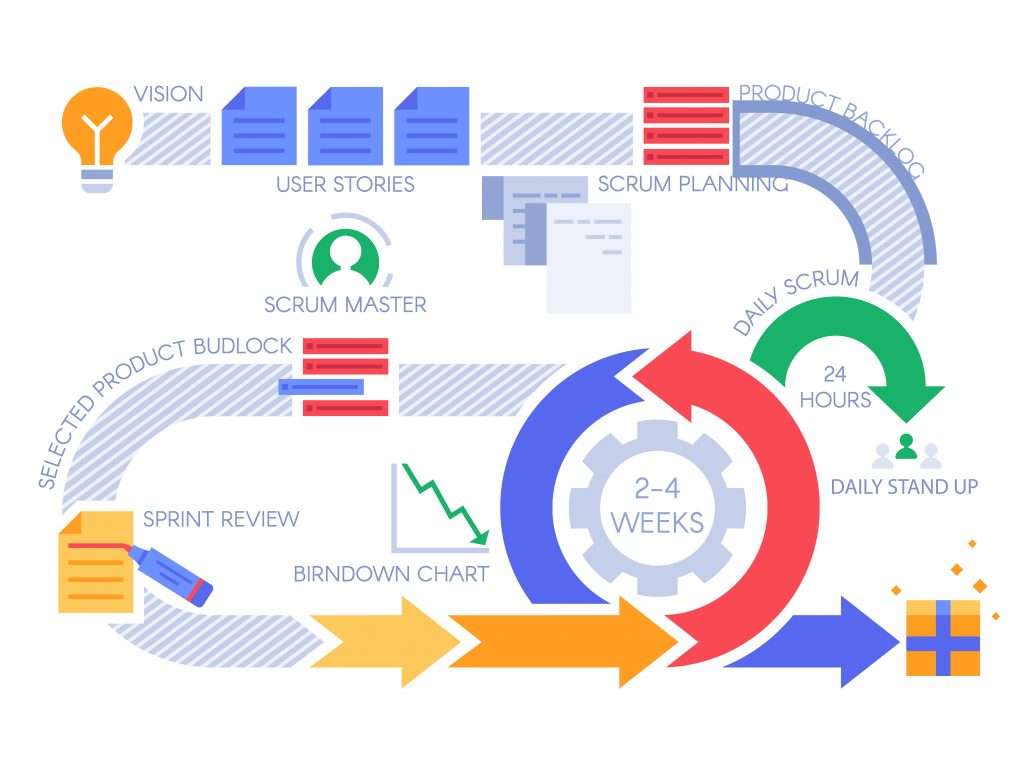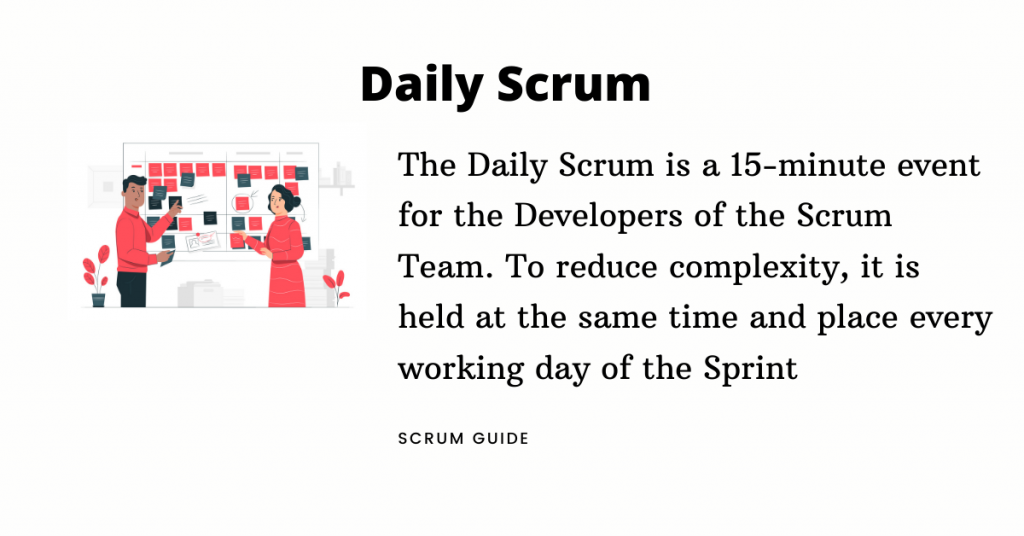There are 5 scrum ceremonies to practice Scrum efficiently. Scrum meetings are the same thing except one clear distinguisher being the sprint itself. Everything else are actually meetings but with a clear goal for the meeting which results in them being referred to scrum ceremonies.
The scrum ceremonies are to create regularity and to minimize distractions on the development team such as meetings. Each ceremony will have a maximum duration to prevent them disturbing the development work. Besides the sprint other ceremonies are used to review and adapt where required. For a complete overview of Scrum check out the 2020 Scrum guide by Ken Schwaber & Jeff Sutherland
| Scrum Ceremonies | Scrum Meetings |
| Daily Stand Up Backlog Refinement Sprint Planning Sprint Review Sprint Retrospective | Daily Stand Up Backlog Refinement Sprint Planning Sprint Review Sprint Retrospective |
The Sprint
Duration: Minimum 2 weeks, Maximum 4 weeks
The Sprint is when the work actually gets done and is the most important Scrum ceremony. Sprints will have a set duration which is to be strictly obeyed regardless if work is completed or not. Remaining work would need to be prioritized again to be added to another sprint.
A new sprint starts immediately after one is complete. Sprints consists of Sprint Planning, Daily Stand-Ups, Development work, Sprint Review and the Sprint Retrospective. Only the Product Owner has the power to cancel a Sprint although they may do so under the influence of the business, Scrum Master or development team. The main reason a sprint would be cancelled if the sprint goal became obsolete but as a general rule sprints shouldn’t be cancelled.
5 Scrum Ceremonies

Backlog Refinement/Grooming
Duration: 1-2 Hours
Backlog refinement is also refereed to as “backlog grooming”, “story time”, “estimation session” or even “backlog maintenance”. Its core purpose is to prepare the Product backlog for Sprint Planning. The Product Owner will identify stories that could be in the next sprint. The team will review these stories to ensure they are correctly estimated and can be selected for the next Sprint.The Scrum Master will introduce estimating games such as…
- Planning Poker
- Estimating Game
After the refinement session stories should be ready to be selected in Sprint Planning for the next Sprint.
Sprint Planning
Duration: Maximum 8 hours for a one-month Sprint
Sprint Planning is the process of selecting what is to be worked on in the next sprint. It is the Scrum Masters responsibility to ensure Sprint Planning occurs and follows time boxed recommendations. Sprint Planning aims to answer two questions…
- What can be delivered in the upcoming Sprint?
- What work is needed to deliver the Sprint?
A Sprint Goal is determined by the Product Owner which is the objective of the Sprint. Then stories from the product backlog are selected by the team that can help achieve the Sprint goal. The team is responsible for selecting the amount of work they can implement without accruing technical debt. Once selected these stories create the Sprint backlog which is the work selected for the next sprint. The Sprint backlog is then prioritized in a way the tasks are organized as they will sequentially be worked on by the team.
Daily Scrum/Stand-Up

Duration: 15 Minutes
The daily stand-ups are 15 minute event which are held each morning at the team area. It is crucial that only team members speak at the daily stand-ups which is a rule enforced by the Scrum Master. Each person is to answer the following 3 questions and should not take more than a few minutes with their update…
- What I did yesterday
- What I plan on doing today
- Any blockers to report
This daily stand-up is an absolute must in any Scrum development methodology as it improves communication and identifies blockers which can be acted upon quickly.
Sprint Review/Demo
Duration: Maximum 4 Hours for one-month Sprint
The Sprint review/demo is an opportunity for the team to demonstrate the work completed in the previous sprint to all stakeholders. The Product Owner will explain the Sprint goal and then the development team will explain issues they encountered and how they overcame such issues. The development team will then demonstrate the product created in the Sprint.
Sprint Retrospective
Duration: Maximum 3 Hours for one-month Sprint
The Sprint Retrospective is where the process is reviewed on what went well and not so well. It occurs after the Sprint Review and prior to the next Sprint Planning. The purpose of sprint Retrospectives is as follows:
- Inspect previous sprint with regards to people, relationships, processes and tools
- Identify potential improvements that can be made
- Create a plan for implementing the identified improvements
The Scrum Master will be the main driving force behind Sprint Retrospectives as they will understand it is a crucial aspect of Scrum.
A Guide to Scrum Meetings
What are the 6 scrum cermonies
The Sprint
Daily Stand Up
Backlog Refinement
Sprint Planning
Sprint Review
Sprint Retrospective
What are the 5 scrum ceremonies?
Daily Stand Up
Backlog Refinement
Sprint Planning
Sprint Review
Sprint Retrospective
